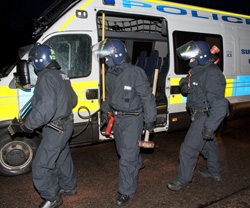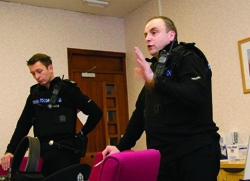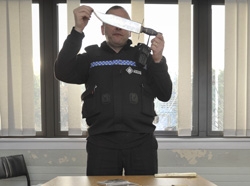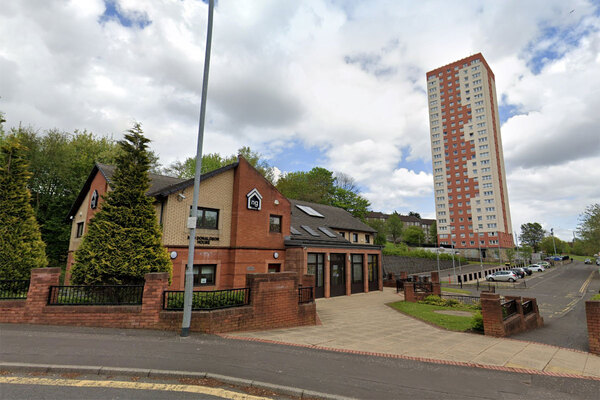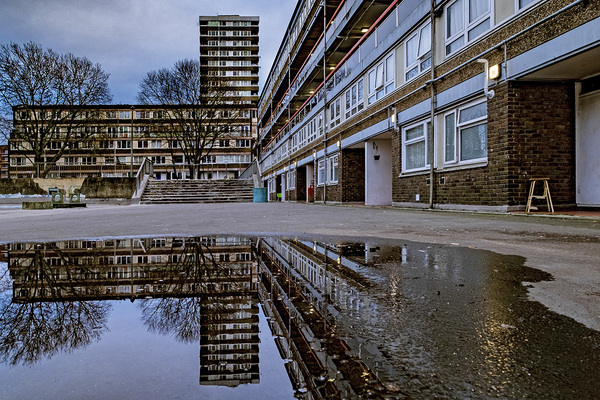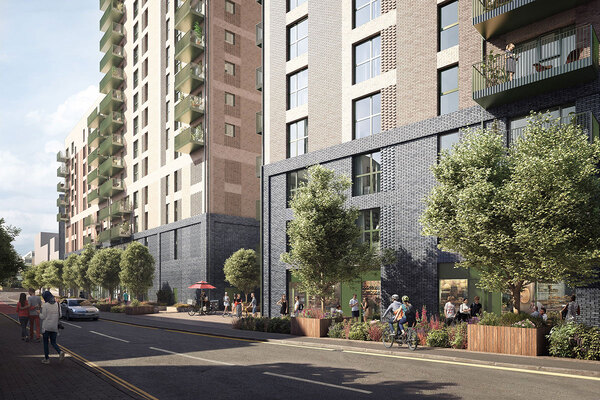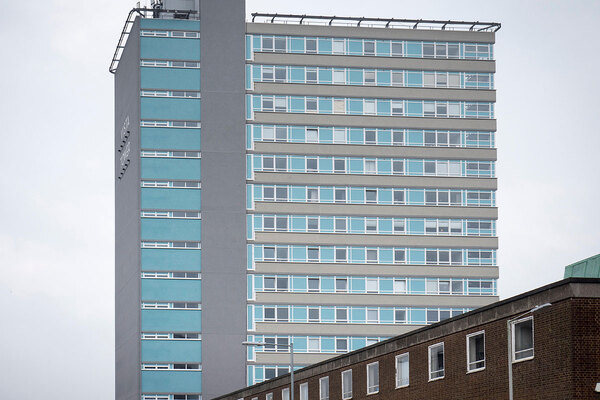May the force be with you
Social landlords are being urged to take a stand against anti-social behaviour. Nick Duxbury joins a drugs bust to see how a unique collaboration between Glasgow Housing Association and Strathclyde Police is leading the charge.
‘We will hit them fast and hit them hard.’ It’s 7.30am in an east Glasgow police station and Sergeant Eddie Seery is briefing nine, stoney-faced Strathclyde Police constables clad in dark Kevlar body armour. In 20 minutes they are going to raid a house from which they suspect heroin is being dealt - and I’m going with them.
‘Watch yourself when you go in here,’ cautions the sergeant - ‘the gaffer’ to the uniforms sitting across the room. ‘Everyone must stay alert at all times. Violence is not on the agenda this morning but that doesn’t mean that it won’t happen.’
The more I hear, the more it sounds like violence almost certainly will happen. The ‘target’, we are told, has a record of violence, and of violence ‘with weapons’. Intelligence says that he is selling heroin and Valium (commonly used by heroin addicts) from the property to a steady stream of buyers.
Sergeant Seery talks through the plan: the route to the house, the procedure for using hydraulics to prise open and ‘breech’ the door, and who enters which rooms first. Roles are assigned using concise but bewildering operational jargon and police acronyms. No one flinches when they are told that, in addition to his violent history, the main target ‘has signals on him for being contagious’ - meaning he has either hepatitis or HIV. ‘When starting the search be very careful and use spit masks in case he decides to start spraying us. Let’s just be very careful.’

Source: Martin Hunter
Fruits of intelligence
Now Constable Gary Ross takes over, speaking gravely while pointing to a board displaying schematics of the house in question - provided by owner Glasgow Housing Association. It shows a video camera installed above the door, which the GHA tenants who live inside have fortified with a wooden barricade. The target is known to keep a single golf club next to the door. Furthermore his live-in partner has a ‘well built’ brother who could also be staying - along with a child and, two teenagers.
This depth of intelligence is possible only as a result of a unique collaboration with GHA. In December the landlord seconded one inspector, two sergeants and 12 constables from Strathclyde Police to help its neighbourhood relations team tackle anti-social behaviour in the Tollcross area of east Glasgow. The association is well placed to trial this partnership as it is one of the largest landlords in the UK and its 53,461 tenants experience their share of ASB; GHA receives an average of 10,000 complaints a year. While other landlords also work in partnership with police, GHA believes it is the first to have operational control of officers on its payroll and to collaborate to such an extent.

Source: Martin Hunter
Call to arms
GHA’s timing for this six-month pilot couldn’t be better. Just over two weeks ago, England’s housing minister Grant Shapps brought ASB to the fore, calling on landlords to use ‘the full range of powers at their disposal to tackle this menace head on’. As part of this push, the Chartered Institute of Housing has assumed responsibility for driving the re-vamped national respect standard to improve landlords’ performance on preventing and tackling ASB. Meanwhile, in England the coalition plans to make it easier to evict tenants who are repeatedly causing ASB.
All this doesn’t mean things will get easier. With police across the UK suffering budget cuts and losing thousands of officers from the streets, resources for policing ASB are likely to become increasingly scarce. In this context, it is hardly surprising that the government is turning to social landlords to pick up the slack.
If GHA’s pilot works, the landlord hopes the concept will be replicated by providers across the UK. This morning’s raid is the first drugs operation to be carried out by the neighbour relations unit policing team. Officially, I am here in Glasgow to see first hand how the collaborative relationship between housing officers and police works - and judge whether or not this could be the future. But mostly, I am itching to see what happens in a drugs bust.
The gaffer wraps up the briefing by reiterating the need to take care - and to put mobile phones on silent (‘it doesn’t look very good if a mobile goes off and there is a daft tune’). And then it’s on.
Everyone files out of the station into the car park. Five minutes later, we are snaking through still-dark, rain-sodden streets, trailing the tail-lights of two police vans moving steadily east through the city. No one says much. The rhythmic hiss of the windscreen wipers and patter of rain is audible as anticipation builds. After around 10 minutes driving, we pull over at the entrance to a street of small, semi-detached homes. And suddenly the raid is happening.
Before we have even come to a halt, officers in helmets and body armour are streaming from the vans and scuttling around the sides of the property. As I undo my seat belt, there is a massive crack as the ‘enforcer’, a 16kg metal battering ram, slams into the front door. No lights come on and no sounds come from within. Another massive crack, and another and another, and another, before, finally, a woman shrieks: ‘Who is that?’ Seconds later, with one decisive crash, the door caves in under the weight of the final blow and uniforms pour into the house. There is shouting and yells of ‘contact’ as police find the suspects. Then silence.
To everyone’s disappointment, no heroin is found at the property. Electronic scales and plastic ‘baggies’ to weigh and wrap heroin are discovered, but, despite the fact the team is certain the target has been dealing, there is no evidence to prove it.
What is recovered, though, are enough blades to chill the marrow of a butcher. Hatchets, meat cleavers, machetes, huge kitchen knives, and even nunchucks - all clearly chosen for maximum intimidation - are strategically placed around the house, though mostly in the main bedroom. The cache speaks volumes about the kind of guests the suspect expects to receive. One officer reveals that the target, despite his fearsome reputation, expressed relief that his early morning visitors were just the police and not one of his rivals.
‘Do you use a machete in your kitchen?’ asks seconded inspector and operation leader Ian Thomson. ‘Or a bread knife in the bedroom? They will say it’s for cutting cheese, or that it is ornamental, but it’s so territorial around here that they have these weapons with the expectation of using them. Even if we don’t get any drugs it is a success for us from a public safety perspective if we can remove weapons from society.’
Perhaps the most disturbing find is a switch blade taken from a teenager who was asleep upstairs. The teenager happily admits carrying this everywhere he goes. Furthermore there are cut marks up and down his arms and dried blood on one of the meat cleavers suggesting a tendency to self-harm.
‘Now we can alert the relevant support organisations and get him help,’ says Inspector Thomson.

Source: Martin Hunter
Decisive action
Brian Healy, strategic advisor on community safety at GHA who leads the association’s ASB team and works alongside Inspector Thomson, says the main benefit of the collaboration for GHA is to be seen to be listening and responding to its customers’ concerns. This morning’s raid embodies that: decisive action laid on for all the street to see. The intelligence gathered along the way can also feed into other police operations, including anti-terrorism work. In the last month alone the team has conducted 400 stop and searches in the Tollcross area.
The arm of the law is only one side of a two-pronged approach to the ASB problem: the threat of eviction can be just as powerful. ‘Often the tenants causing ASB say we are worse than the police because we can take a roof away from over their heads while the police judicial review system is a known quantity to them,’ explains Mr Healy. ‘When their behaviour starts to impact on their own families’ futures, then heads turn. That said, for us, we have failed if we have to evict someone.’
‘Terminating tenancies is a useful tool for us,’ agrees Inspector Thomson. ‘By working together, we can actually influence behaviour with that threat and intervene to prevent crime. It’s simply common sense. It builds a support mechanism into the equation with neighbours and kids. We don’t want to just displace a problem by enforcing the law, and this initiative means we don’t. This takes our tactics and GHA’s tactics and meshes them together.’
The unique nature of this ‘joined up’ partnership appears to be more than just good PR. Inspector Thomson is based in a GHA office and sits opposite Mr Healy. Every Tuesday morning all team members - housing and police officers - collectively work through the problems, allocating responsibility to specific individuals to mark a clear line of accountability. For instance, this morning’s raid was the fruit of a Tuesday meeting held just days before my visit in which intelligence was shared.

Source: Martin Hunter
Violence
While heroin busts are relatively rare, other problems such as ‘indoor violence’ are not. This daily problem is especially prevalent in Glasgow where a zero-tolerance approach to drinking outdoors leads to a lot of noisy drinking parties inside people’s homes - many of which end in violence. Inspector Thomson says these contribute to many of the city’s murders and stabbings - not to mention keeping the neighbours up. In its first few weeks, the team compiled a list of the top 12 worst offenders among their Tollcross tenants and cold-called them, issuing warnings from the police and from GHA that they could be evicted if they return to their partying ways. Their behaviour is now monitored weekly.
The partnership can be seen working in even the most mundane examples. A door is off its hinges; not usually a police matter, but one that can lead to other problems which are. In such a case a constable will show their face in a gesture of reassurance and make sure that GHA’s repairs team sorts the problem. Inspector Thomson even cites dog mess as a priority under this initiative as it is a particular concern for GHA’s Tollcross residents.
Other problems are harder to tackle. Housing staff tell me that domestic violence, for example, is worst when Celtic play Rangers and passions are running high - but intervention is difficult. However, even as we chat, a case in which a mother is being abused by her son is raised by housing staff. The mother is coming in to speak to her housing officer, and already Inspector Thomson is taking details and is keen to find a way the police can help her.
In this case the targeted partnership work I have heard so much about would involve housing officers seeking evidence of violence and asking questions when visiting homes in which abuse is suspected. This would then be shared in the meetings where, according to Inspector Thomson, everything is openly discussed. But is this sharing of information compromising trusted relationships with tenants?
Meura MacGregor, housing operation manager at the Tollcross office, says not. ‘Housing officers understand the trust in them,’ she says. ‘They would always work in the best interest of the tenants - they know how to treat people. The main aim is to make sure tenants feel safer. So far tenants seem to be pleased to see us working closely with the police and we just hope people will feel more confident in coming to us now.’

Source: Martin Hunter
The bill
Although the partnership model appears to be working, there is a hurdle to overcome if it is to be replicated by other social landlords - the cost. Paying 15 police officers to work full time for an organisation does not come cheap: the six-month pilot cost around £360,000. Although it is a partnership, so the costs are shared, GHA picks up the majority of the tab. While a large landlord like GHA might be able to manage to do this, smaller organisations are likely to find the expense out of their reach. GHA chief executive Martin Armstrong argues that there are long-term cost savings that will make it a worthwhile investment for other organisations.
‘There are practical benefits in terms of a reduction in the cost of repairs and vandalism, and savings in man hours of housing staff,’ he says. ‘Police tackling anti-social behaviour frees up housing staff to prioritise their workload, be proactive in the community, clean up open spaces in the area, collect arrears, improve tenancy sustainment. We see the pilot’s value in terms of improving our neighbourhoods, using resources effectively and with maximum impact. We are sure this type of joint working is the future.’
Back in the Tollcross office, GHA housing officers survey the pile of blades their police colleagues have brought to show them. The initial buzz of seeing the haul evaporates as it registers that without this pilot they could have been on the receiving end of a machete or hatchet.
I’m struck by a sobering thought: whereas I, an observer, had the benefit of watching the drugs raid from outside the house and with the protection of armoured police officers, the vast majority of front line housing staff when they knock on their tenants’ doors tasked with tackling ASB, do not.
Mr Shapps’ plans
Two weeks ago England’s housing minister Grant Shapps proposed the introduction of an additional mandatory ground for possession. This would allow social landlords in England to evict tenants with a track record of anti-social behaviour more quickly.
Currently it can take more than a year to evict a tenant. Under Mr Shapps’ plans, tenants previously found guilty of ASB could be automatically evicted in a county court without having to prove ASB a second time. He is looking at using probationary tenancies for anti-social residents and has put aside £300,000 to help tenants and landlords tackle the problem. However, lawyers are already warning that recent cases mean a new ground for possession is likely to face human rights challenges from tenants.
